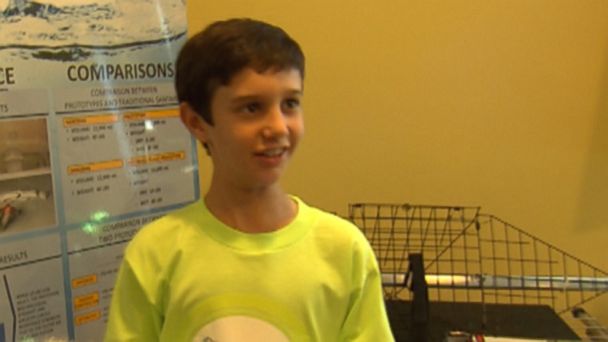Sixth-Grader Invents Sandless Sandbags to Save Lives and Property in Floods
Peyton Robertson, 11, of Fort Lauderdale, Fla., has the enthusiasm of an infomercial king and the ingenuity of Thomas Edison.
The sixth-grader put his math and science skills as well as some real-life experience to use and created something that could help people and property during floods - the sandless sandbag.
Today he was named the winner of the Discovery Education 3M Young Scientist Challenge for his sandbag, which could revolutionize the way we protect ourselves from flooding.

ABC News
"I had a really terrifying experience with a hurricane," said Peyton, who attends Stanford University's Middle School. "When I was 4, I experienced [Hurricane] Wilma."
As Hurricane Wilma whipped overhead in October 2005, Peyton and his family huddled in a closet and watched the storm bring damage and death to their area. Wilma - the third hurricane of the 2005 season to reach category 5 status and the most intense tropical cyclone ever recorded in the Atlantic - killed at least 62 people in its entire trajectory.
Related: Seven of the most devastating storms to hit the United States.
"Eighty percent of the $44 billion in damage since 2005 was caused by saltwater flooding," Peyton said. "[But] Superstorm Sandy [in October 2012] really made me think about how people can prepare for floods."
Peyton, who has been solving math problems since he was 3, eventually came up with the sandless sandbag.
"Instead of filling it with sand, I filled it with just the right amount of ultra-fluid polymer," he said. "What's amazing is that when you pick these bags up and they're not wet, they only weigh a pound or two."
Unlike regular sandbags, which are heavy and hard to carry, Peyton's is filled with chemicals and salt that only expand when doused with water. The bags are ultra-portable when they are dry and will not float away when they are wet.
Experts lauded his invention and said that the sandless sandbag could someday save innumerable lives and property.
"He understands the big picture. He thinks in terms of the impact on society. He's thinking in terms of safety for the people around this area," said Dr. Antonio Nanni, the engineering chair at the University of Miami. "He's got a great idea. We'd love to have him at [the University of Miami.]"
Peyton, though, has to get through middle school and high school first, but until then, the young scientist will continue tinkering and inventing,